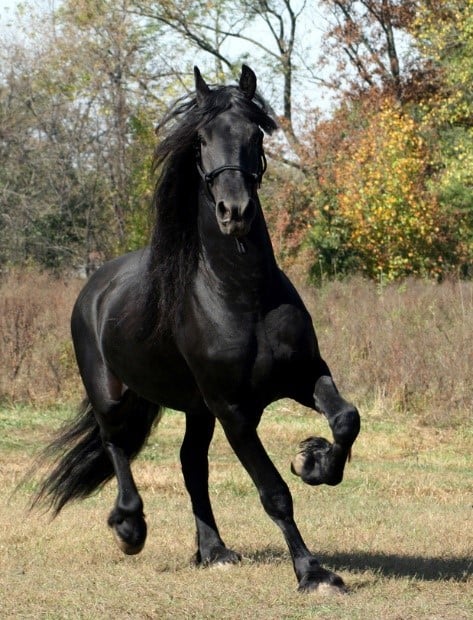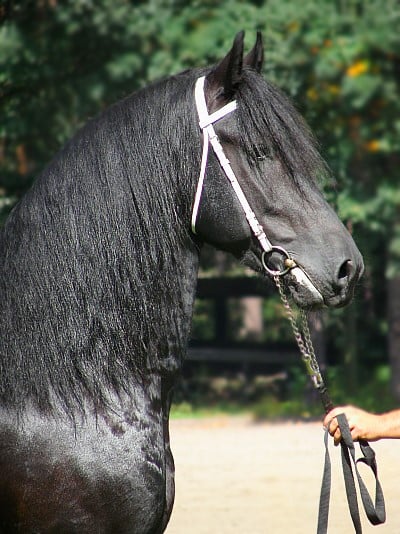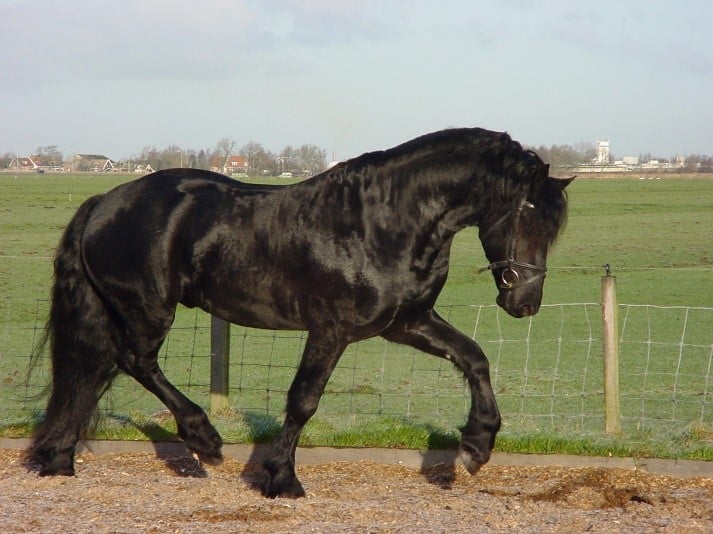Should You Buy a Friesian Horse: Facts, Traits, and Temperament
I’ll never forget the first time someone let me ride a Friesian horse. I was 14 years old… sitting on the side of the dressage ring while my instructor helped another student with her jet black gelding.

Many people are captivated by all types of Friesian horses. It’s a very old breed with talent in many different riding disciplines. Here, we’re going to break down all of the main traits, characteristics, and maintenance tips you’ll need for your Friesian horse. Whether you’re using it for driving, dressage, or simply pleasure, we hope this article helps you decide if a Friesian horse breed is right for you!
You may also be interested in:
Palomino Horses - The Golden Horses That Steal the Show
Everything You Need to Know About Buckskin Horses
13 Dapple Grey Horse Facts That Will Blow Your Mind
Get to Know the Friesian Horse Breed
Carrying Knights into Battle!
Every breed of horse has their own unique story to tell. And with Friesian horses, their story involves epic battles with knights in full suits of armor!
That’s because the very first types of Friesian horses originated in an area of the Netherlands known as Friesland. We can actually find mention of these black, muscular war horses as far back as the 4th century. People started drawing pictures of their favorite war-time mounts by the 11th century. They show knights like William the Conqueror riding into battle with powerful black horses leading the charge.
Really, when you think of a Friesian horse, their powerful black body, muscular frame, and elegantly arching neck is often the first thing that comes to mind. These horses are perfectly built to carry riders of all types through the pages of history.
If we look back into the Middle Ages, we can find soldiers who desired Friesian horses that could handle huge suits of armor. In fact, by the Late Middle Ages, people were purposefully breeding the horses to make them even stronger and heavier.
It wasn’t until the 16th and 17th centuries when lighter versions of the Friesian horse breed were finally introduced. This was accomplished when they were bred to lighter Spanish breeds like the Andalusians (which happens to be another dream horse ride on my bucket list!)
Friesian Horses Come to America
By the time the 17th century rolled around, European Friesian owners were starting to make their way across the Atlantic Ocean. When the Dutch settled in the New York area – which they called New Amsterdam – they brought along their Friesian horses. But, this didn’t last long and the breed all but disappeared within a few decades.
Then, Friesian horse breeds were reintroduced to the United States in 1974. They were used as modern shown horses and also prized as pleasure mounts, shown as parade horses, and used for exhibitions. Everyone loved this flashy breed with its calm temperament and raw horse power.
Friesians in the Modern World
There’s not a whole lot Friesians can’t do. For a time, they were very popular as harness horses and work horses in agricultural fields. They also excelled at trotting races popular in the 18th and 19th centuries.
Breeders took notice of this versatile horse and used them as foundation stock for breeds like the Dole Gudbrandsdal, Norfolk Trotter, and the Morgan horse breeds.
They aren’t necessarily great for racing or show jumping, but they can do really well in a variety of other disciplines. You might find Friesians being ridden saddle seat, hunter seat, used for western riding, or carriage driving. Carriage driving is especially important because their upright head carriage, flashy high-stepping trot and uniform black appearance makes them a beautiful addition to any fancy carriage.
Breed Characteristics of the Friesian Horse
If you’re thinking of buying a Friesian horse, you’ll want to get a good understanding of what this breed has to offer. Here are some of the basic breed characteristics.
Friesian horses are not always black in color.
While black is likely the color you most likely imagine, not all Friesian horses are black. Some bloodlines carry a chestnut gene known as the “red” or “e” gene. It wasn’t uncommon to see a chestnut or bay Friesian horse in the 1930s, but they are much rarer today.
That’s because many European breed registries don’t accept chestnut Friesians into their books. However, the American Friesian Association does allow chestnut horses in their registries. As of 2014, only eight stallions are known to carry the chestnut gene. The only markings allowed for purebred registration are a small star on the forehead.
Friesians are 14.2 to 17.0 hands in height.

Read: How to Find the Best Warmblood Horse Trailers
Friesians are beautiful animals with powerful, sloping shoulders, compact, and muscular bodies. Their most incredible feature is probably their long, arched neck and short-eared head.
They have a great temperament with a calm demeanor. They are eager to learn new skills, social with other horses, and pleasant with their owners. Best of all, they don’t tend to spook like some other horse breeds.
The different types of Friesian horses.
In the Netherlands, Dutch judges called keuring look over horses and decide if they are worthy of certain breeding designations. For instance, a “star designation” is given to a horse that is at least 15.2 hands and meets quality standards for health and conformation. Today, 7% of the horses in the Netherlands are Friesians.
Friesians are graded soon after birth and then again when they are a few years old. This is when they are classified and entered into the foal book as 1st, 2nd, 3rd, or “no premie.” They are later classified into breed groupings called predicates.
The main Friesian predicates are:
- Ster Predicate
- Sport Predicate
- Crown/Kroon Predicate
- Model Predicate
There are two main types of Friesian horses. Both of them have a powerful overall conformation and good bone structure. The “Baroque” body is a more robust build and is considered the classical Friesian body type. Then, a more modern “Sport Horse” type has a finer bone structure.
Since they are a mixture of cold-blooded and hot-blooded horse breeds, Friesians are considered “warmblood horses.” (As an example, an Arabian is a hot-blooded horse.)
Friesians Horse Riding Disciplines
After their time carrying knights into battle, Friesian horses became very popular as work horses in farmer’s fields. But, when modern farming equipment came around, more and more people started using Friesians for sport.
A horse’s individual training certainly plays a role. But once trained, Friesian horses can work well for both beginner and advanced riders.
As we mentioned before, Friesian horse breeds are perfect for use in harness pulling carts and carriages. They carry themselves with a distinct animation and elegance that is a real crowd pleaser. Plus, Friesians have a brisk, high-stepping trot that looks fantastic at the front of a carriage. Friesians can also be used for saddle seat, hunter seat, used for western riding, and dressage.
Read: Dressage Secrets Revealed: How This Classical Riding Style Can Help ANY Breed in ANY Discpline
Use in the Dressage Discipline
The sport of dressage is filled with warmblood horses who seem to dance effortlessly around the show ring. In truth, this discipline requires very high levels of strength and perfect communication with the rider. When done well, it looks effortless.
Both types of Friesian horses – Baroque and Sport Horse Types – can be used successfully for dressage. In fact, this breed’s rise in dressage popularity started when a stallion named Adel 357 was first shown at the International Grand Prix level.
Here’s a video of a Friesian being used for Grand Prix Dressage.
Friesian Horses, Movies, and Television!
If you’ve ever seen a movie with knights charging into battle, there’s a good chance a Friesian horse is leading the way. That’s because this breeds looks and performs really well on movie and television sets. Directors for historical and fantasy productions love using Friesians because they look great. More importantly, their calm temperament means they won’t spook at strange-looking equipment, loud noises, or crowds of strangers on the movie set.
Caring for Friesian Horse Health Concerns
We’ve spent a lot of time talking about the pros of buying a Friesian horse, but now it’s time to take a look at a few of the cons. There are several health concerns you should be aware of in advance. First off, there are several genetic disorders Friesian horses are more prone to display.
Genetic Disorders in Friesian Horses
Dwarfism – This condition only affects about 0.25% of all Friesian horses. It results in a horse with a normal sized head, a broad chest, long back and very short limbs. There are genetic tests that can determine if a horse carries this gene.
Hydrocephalus – When spinal fluid builds up in the brain it can create pressure and lead to health problems. Again, genetic testing is available for this condition.
Aortic Rupture – The aorta is the largest artery on the horse, so a rupture here is the last thing you want.
Megaesophagus – This condition can be a problem because an enlargement of the throat makes it hard for the horse to swallow and they are more prone to choke.
 Other Health Concerns to Know About
Other Health Concerns to Know About
Equine polysaccharide storage myopathy – Friesians may develop this condition which only shows up in a several breeds of horses. This looks a lot like colic in extreme cases and comes from a lack of glycogen in the muscles. It is treatable with a diet adjustment.
Digestive system disorders – Friesians are more likely to experience colic and other gastrointestinal problems than other breeds.
Insect bite hypersensitivity – No one likes mosquitos and flies, but Friesians tend to have a more extreme reaction to bites than other horses. It can lead to hair loss and skin damage.
Retained placenta after foaling – Friesian mares have a high 54% chance of retaining their placenta after foaling.
Grooming and Maintenance Tips
Friesians do tend to be high maintenance horses. Here are a few tips to make sure you keep them looking and feeling their best!
1. Brush out the mane and tail
With a great mane comes great responsibility! Take care of your Friesian horse’s mane to keep it untangled and free from burrs. Serious Friesian owners and breeders will groom their horses daily. They may keep the long mane braided so it doesn’t tangle and get burrs from the pasture.
It’s also recommended top put their long tails in a tail bag for protection. Adding a product like Premium Show Sheen can help keep hair shiny and free from tangles.
2. Take special care with skin
Friesians do tend to have dry skin and can develop rashes quickly. That’s why they should be groomed and washed regularly. Also be aware that they have hypersensitivity to bug bites, so you’ll want to make sure they are sprayed often with fly spray and your farm is free from environments where flies and mosquitos will thrive. Keep manure piles cleaned up and avoid standing pools of water where mosquitos can breed.
3. Protect their coat
Don’t take that jet black coat for granted. The black coat of a Friesian can actually fade in the sun. That’s why you may want to exercise your horse in the early morning and turn out in the evening hours when the sun is low in the sky. Then, during the middle hours of the day, keep your horse in the barn.
A highly nutritious diet also helps promote a healthy coat. You’ll want to use a high-quality shampoo when washing your Friesian. Check out something like Shapley’s Hi Shine Shampoo, or Medi-Care Med Shampoo with Tea Tree and Lemon Grass.
4. Clean their fetlocks
The beautiful hairy fetlocks on Friesians – known as “feathers” should be washed regularly with an anti-bacterial shampoo. Then, towel dry and blow dry the hair for best results. This way, no moisture is left behind that can lead to skin irritation.
It also helps prevent skin conditions like Pastern Dermatitis. This is irritation of the lower legs under their dense patches of hair. This condition is common in feathered breeds like Friesians. If left untreated, Pastern Dermatitis can lead to leg swelling, oozing scabs, and even open sores!
5. Provide the correct shelter
Friesian horses are from the Netherlands originally, so they are happiest in cold weather climates. They don’t tolerate heat and are prone to anhydrosis. This means they don’t always sweat enough to keep their body cool. That’s why some owners choose to give their Friesians Vitamin E injections with fluids and electrolyte injections in the warmer months.
Frequently Asked Questions
What is the average cost of a Friesian horse?
You can expect to pay around $30,000 for a Friesian horse, but they can cost much more depending on their bloodlines, age, and level of training. Here is a great website that lists Friesians for sale: equinenow.com
Are Friesians hard to ride?
Friesians have a calm temperament and can be suitable for riders of all skill levels.
How rare is a Friesian horse?
Friesians make up about 7% of the horse population in the Netherlands. In the United States, you’ll find around 8,000 Friesian horses.
Are Friesian horses always black?
Not all Friesian horses are black. Friesians can also come in chestnut and bay colors although this is much rarer.
Do Friesians make good dressage horses?
Friesians are becoming more and more popular as dressage horses. They also excel in a variety of other riding disciplines including saddle seat, hunter seat, western riding, and carriage driving.
Where do Friesians originate from?
Friesian horses originated in the Netherlands in the Friesland province in the Middle Ages.
Is a Friesian horse high maintenance?
Friesian horses tend to be high maintenance and require regular grooming of the mane, tail, coat, and feathered fetlocks. They are also prone to certain genetic or medical conditions like dwarfism, hydrocephalus, aortic rupture, magaesophagus, equine polysaccharide storage myopathy, digestive system disorders, insect bite hypersensitivity, pastern dermatitis, and retained placenta after foaling.
What are some genetic disorders common in Friesians?
Friesians are more likely to get genetic disorders like dwarfism, hydrocephalus, aortic rupture, and magaesophagus.

 Other Health Concerns to Know About
Other Health Concerns to Know About